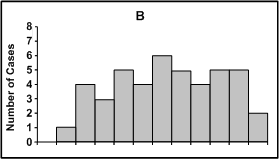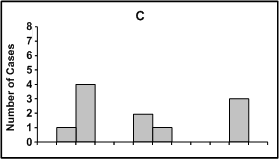Lesson 6: Investigating an Outbreak

Self-Assessment Quiz
Now that you have read Lesson 6 and have completed the exercises, you should be ready to take the self-assessment quiz. This quiz is designed to help you assess how well you have learned the content of this lesson. You may refer to the lesson text whenever you are unsure of the answer.
Unless instructed otherwise, choose ALL correct answers for each question.
- Which are the most common ways that a local health department uncovers outbreaks?
- Performing descriptive analysis of surveillance data each week
- Performing time series analysis to detect deviations from expected values based on the previous few weeks and comparable periods during the previous few years
- Receiving calls from affected residents
- Receiving calls from healthcare providers
- Reviewing all case reports received each week to detect common features
- Factors that influence a health department’s decision whether or not to conduct a field investigation in response to one or more cases of disease include:
- The nature of the disease
- The number of cases
- Resources available
- Health department’s traditional attitude toward conducting field investigations
- If a particular outbreak presents an unusual opportunity to learn more about the disease and its epidemiology by conducting a study, but early disease control measures would interfere with the study, one should conduct the study quickly, then implement control measures immediately afterwards.
- True
- False
- Use the following choices for Questions 14a–c.
- Disease control and prevention efforts take priority over investigation efforts
- Investigation efforts take priority over disease control and prevention efforts
- ____ Outbreak with known causative agent, source, and mode of transmission
- ____ Outbreak with known causative agent, but unknown source and mode of transmission
- ____ Outbreak with unknown causative agent, source, and mode of transmission
- Use the following steps of an outbreak investigation for Question 5:
- Analyze data by time, place, and person
- Conduct a case-control study
- Generate hypotheses
- Conduct active surveillance for additional cases
- Verify the diagnosis
- Confirm that the number of cases exceeds the expected number
- Talk with laboratorians about specimen collection
For an investigation of an outbreak, what is the logical conceptual order of the steps listed above?- 1-2-3-4-5-6-7
- 5-6-4-1-2-3-7
- 6-5-3-1-2-7-4
- 6-5-7-4-1-3-2
- To avoid skipping a critical step, investigators should conduct the steps of an outbreak investigation in the precise order you answered in Question 5.
- True
- False
- Use the following choices for Questions 7a–c.
- Cluster
- Epidemic
- Outbreak
- ____ 200 cases of Marburg virus infection in several districts in Angola over several months (usually none)
- ____ 40 cases ofSalmonella Enteritidis in 1 week traced to a single meal served at a cafeteria (usually none)
- ____ 10 cases of cancer diagnosed over 2 years among residents of a single neighborhood (previous data not available)
- Why should an investigator who has no clinical background nonetheless talk to a patient or two as an early step in the outbreak investigation?
- To advise the patient about common risk factors and the usual course of the illness, after reviewing such information in appropriate reference material
- To develop hypotheses about the cause of the outbreak
- To learn more about the clinical manifestations of the disease
- To verify the clinical findings as part of verifying the diagnosis
- To verify the laboratory findings as part of verifying the diagnosis
- A case definition during an outbreak investigation should specify:
- Clinical features
- Time
- Place
- Person
- Hypothesized exposure
- Ideally, a case definition is 100% accurate in identifying who does and does not have the disease in question, but in reality few case definitions achieve this ideal.
- True
- False
- Once a case definition for an outbreak investigation has been established, it should not be changed.
- True
- False
- Common methods of identifying additional cases (expanding surveillance) as part of an outbreak investigation include:
- Advising the public through newspapers, TV, radio, and the health department’s website to contact the local health department
- Asking case-patients who they were with at the time of exposure (if known)
- Sending a fax to healthcare providers
- Telephoning the infection control practitioners at local hospitals
- A case report form devised for an outbreak investigation usually includes which of the following types of information?
- Identifying information
- Demographic information
- Clinical information
- Risk factor information
- Reporter, interviewer, or data abstractor information
- Descriptive epidemiology is essential for “characterizing the outbreak” by time, place, and person, but has little bearing on the analytic epidemiology.
- True
- False
Use the following epi curves as choices for Questions 15a–c.
- Match the epi curve with the outbreak description.
- ____ A malfunctioning space heater was used each time the outside temperature dropped below freezing
- ____ At the Eclipse Restaurant, sodium nitrite was mistaken for table salt in the preparation of breakfast one morning only
- ____ Common cold passed from classmate to classmate
- A group of tourists on a weeklong bus tour of a European country experienced an outbreak of norovirus. The group had followed a consistent meal time pattern: each morning they had breakfast together in whichever hotel they had stayed from 6:00 a.m. to 7:00 a.m., stopped for lunch from 1:00 p.m. to 2:00 p.m., then had dinner together either at the next hotel or at a restaurant at about 7:00 p.m. The incubation period for norovirus is about 24-48 hours, with a median of about 33 hours. On which day and at which meal was exposure most likely?
- April 19 Dinner
- April 20 Breakfast
- April 20 Lunch
- April 20 Dinner
- April 21 Breakfast
- Possible explanations for a case that occurs substantially later than the other cases in an outbreak include:
- Similar but unrelated disease
- Secondary case
- Case with unusually long incubation period
- Time of exposure later than others
- Error in recording date
- A spot map is particularly useful for displaying:
- Geographic location of exposure of each case-patient
- Residence of each case-patient
- Incidence rate of disease by area
- Prevalence rate of disease by area
- Which of the following may be useful in generating hypotheses in an outbreak setting?
- Review the literature
- Look at the descriptive epidemiology
- Look at the outliers
- Talk with the local health authorities
- Talk with a few of the case-patients
- Talk with subject matter experts
- The key feature of an analytic (epidemiologic) study is: (Select only one answer)
- Analysis by time, place, and person
- Calculation of a risk ratio or odds ratio
- Use of Epi Info to analyze the data
- Presence of a comparison group
- Disease control measures can be directed at the:
- Agent
- Source
- Mode of transmission
- Portal of entry
- Host susceptibility
Use the information in the following paragraph and data in the table for Questions 22–25.
An outbreak of gastrointestinal disease occurred 24-36 hours after people had attended a wedding. Of the 203 attendees (including the bride and groom), 200 completed questionnaires, and 50 reported illness compatible with the case definition. Tabulated food consumption histories are presented in the table below.
| Ate Specified Food | Did Not Eat Specified Food | |||||
|---|---|---|---|---|---|---|
| Food Item | Ill | Well | Total | Ill | Well | Total |
| Punch | 46 (25%) | 138 | 184 | 4 (25%) | 12 | 16 |
| Wedding Cake | 45 (45%) | 55 | 100 | 5 (5%) | 95 | 100 |
| Sushi | 10 (91%) | 1 | 11 | 40 (21%) | 149 | 189 |
- This study is an example of a retrospective cohort study.
- True
- False
- The most appropriate measure of association for these data is the:
- Attributable risk percent
- Chi-square
- Odds ratio
- Risk ratio
- Which food is the most likely culprit?
- Punch
- Wedding cake
- Sushi
- Can’t determine from the data presented.
- Must be more than one food.
- Results of this outbreak investigation should be communicated to:
- The caterer
- Local officials
- Wedding party family and attendees
- World Health Organization




